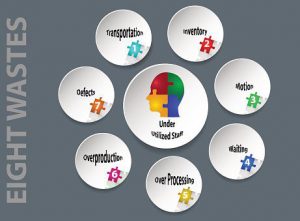For some people, it doesn’t seem possible that Lean Six Sigma can help them in their profession. In manufacturing, sure, or technology or healthcare, but not every industry.
As it turns out, however, Six Sigma actually can help make improvements in just about every line of business. That includes those who make a living arguing in courtrooms.
The drivers behind law firms using Six Sigma are the same drivers behind every business that applies Six Sigma methodology: increased efficiency for the business and increased value for the customer.
Global law firm Clifford Chance so believes in process improvement that they quote legendary statistician W. Edwards Deming in a report they produced on the issue:
“If you can’t describe what you are doing as a process, you don’t know what you are doing.”
How Lean Works
Like any other industry, law firms face challenges in reducing costs, increasing efficiency and delivering the best product possible to clients.
Six Sigma was initially developed for manufacturing by Motorola in 1986. Jack Welch then adopted it as a cornerstone methodology for behemoth General Electric in the 1990s. Six Sigma calls on organizations to define, measure, analyze, improve and control a process, which together helps eliminate mistakes. It’s a process decades ahead of its time in using data to make decisions.
Lean Six Sigma has become more popular in recent years. It focuses primarily on eliminating waste and increasing the speed of a process. Waste falls into eight general areas: defects (or mistakes in a process), over production, time spent waiting, non-utilized or under-utilized talent, transportation, inventory management, wasted motion and extra-processing (essentially, downtime).
Even at a glance, Lean makes sense. It’s also apparent it can be applied to every process imaginable, from assembling pickup trucks on the plant floor to managing chores in a large household.
So how can it apply to law firms?
Lean and Legal
Law firms have a large number of processes that occur on a daily basis. Tasks involving a large amount of paperwork are a routine part of every firm’s operations. In its report on process improvement, Clifford Chance noted a few specific examples where Lean principles were applied with success.
Document review – Every legal case typically requires a lengthy review of legal documents. Depending on the case, the number of documents and emails associated with a legal matter can reach the hundreds of thousands. Clifford Chance sped up the process by creating formal communication times for paralegals and junior lawyers working on reviews to meet with senior litigators. They also communicated questions daily and were given immediate feedback. The firm also developed a standard template for review protocol. All of this sped up the process significantly.
Bound volumes – Volumes containing all the pertinent documents at the end of a case are produced by the thousands each year. The law firm cut down on the process time for the volumes by leaning more on technology to create digital records. They also started the process earlier in the case, rather than waiting until the end. They reduced the cost of creating bound volumes by 60% and the time by 80%.
Working with clients – Clifford Chance also identified areas where asking for client feedback helped speed up processes. Based on experience over many decades, the firm is now able from the outset to let clients know early in a case what they will need to provide, including making specific employees available for consultation and providing certain documentation.
Another example comes from the Ogletree Deakins law firm with locations across the United States and Europe. Ogletree Deakins gives Lean Six Sigma training to leaders within the firm, as well as administrative staff. They also strive to develop best practices for efficiently handling employment litigation.
The firm gathers data on performance as a metric, using surveys of clients who offer feedback on their relationship with the firm.
Process Maps
One important area that can aid law firms is the development of process maps. This requires everyone on a project to come together to develop a clear picture of the issue that needs to be addressed and the methods to address it.
In short, it literally keeps everyone involved on the same page.
A lot goes into developing a process map. Some of the major steps include:
- Establishing clear boundaries for a project. This eliminates scope creep, in which a project begins to spin out into areas that were not originally part of the plan
- Identifying each step of the process
- Putting those steps in the proper order
- Reviewing the map (typically, it’s good to have someone from outside the work group do this)
- Put the map into action, making adjustments as needed
Challenges
Generally, the biggest challenge for the legal profession is the snowflake problem: no two cases are exactly alike. Because the service they produce has variations depending on the legal matters involved, it is difficult to collect accurate or actionable data from one case to the next.
However, as in the examples above, there are areas where firms can leverage Lean methodology. While opportunities vary depending on the law firm and the cases involved, they typically begin in one of three places.
- Senior partners who know the details of a firm’s operations and who also have years of feedback from clients
- Shifting market expectations cause a client to reevaluate the time and cost involved in completing a transaction
- Junior lawyers and others who work day-to-day in certain areas identify situations where time and money are wasted
Clearly, there are opportunities in the legal profession for applying Lean Six Sigma. As with all operations, the methodology provides enough flexibility to allow for its use in a vast number of situations.
It’s up to the individual organizations – in this case, law firms – to identify areas where Lean Six Sigma can apply. The effort is worthwhile. It can result in lower costs, more timely delivery of services and, ultimately, a better experience for clients.




